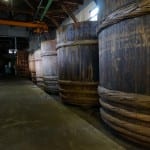This article originally appeared in Sake Industry News Issue #21
 Marketing from within has never been a forte of the sake industry. Yes, it should have been, and had the industry cooperated on that front years ago then sake would not be a measly six percent of all alcohol consumed in Japan. But the past is behind us, and it is interesting today to look at marketing efforts, and in particular cooperative marketing efforts, within the sake industry.
Marketing from within has never been a forte of the sake industry. Yes, it should have been, and had the industry cooperated on that front years ago then sake would not be a measly six percent of all alcohol consumed in Japan. But the past is behind us, and it is interesting today to look at marketing efforts, and in particular cooperative marketing efforts, within the sake industry.
Bear in mind that in the mid 70’s, sake was at its peak in terms of consumption, in fact the market was three times bigger than it is today. To put it more bluntly, sake has dropped to one-third of what it was at its peak in 1973.
But things are turning around – sort of, and in a number of ways. A shift to premium and more expensive products, as well as a changing of the guard in terms of company ownership are two of the more visible ways things are changing. Add to this the younger generation taking over seem to be a bit more willing to market than their predecessors.
Actually, that “younger” generation is not that much younger. 25 years ago when I began working in the sake industry, whenever I was with a bunch of brewers I was always the youngest in the group. Now I am almost without exception the oldest. Then again, I myself have aged a bit in the past 25 years. But I digress.
Back to sake marketing efforts, there are handful of examples of mostly young kuramoto that are from the same prefecture uniting to promote their sake as a team. Some of these have been around for a while and others are just getting started – or at least just kicking things into high gear. I have been interested in such efforts for a while but have not taken the time to list them all up and compare them. Yet, I am sure it is a moving target and hard to concretely assess. Nevertheless, Here is a rundown of a few that I think are worth noting.
Next Five
 Next Five was formed in 2010, and is a group of five brewers in Akita Prefecture whose stated objective is to discover what sake of the next generation will be, and to be leaders going into that. They do a number of promotional activities, focusing mainly on three things: sake tasting events, other social and artistic events around which sake can be enjoyed, and all gathering each year at one of the five breweries and working together to make one sake together, with each one of them taking on one of the indispensable roles in sake brewing each time. I have also read that their plan was to have each member step down as they get older and replace them with like-minded younger brewers so as to keep the spirit of the next generation alive, although I am not sure if that has actually taken place. From my perspective they are the most visible, at least until recently.
Next Five was formed in 2010, and is a group of five brewers in Akita Prefecture whose stated objective is to discover what sake of the next generation will be, and to be leaders going into that. They do a number of promotional activities, focusing mainly on three things: sake tasting events, other social and artistic events around which sake can be enjoyed, and all gathering each year at one of the five breweries and working together to make one sake together, with each one of them taking on one of the indispensable roles in sake brewing each time. I have also read that their plan was to have each member step down as they get older and replace them with like-minded younger brewers so as to keep the spirit of the next generation alive, although I am not sure if that has actually taken place. From my perspective they are the most visible, at least until recently.
The five brands of sake involved are Shirataki, Aramasa, Yukino Bijin, Ippaku Suisei, and Harugasumi.
However, the idea was apparently inspired by a group of five brewers in Hiroshima that formed a group called the Konshikai, that gathered each year to critically assess each other’s sake in the spirit of improving all of their sake. Just last year I read of two of them exchanging kōji, in other words, two breweries (Kamo Kinshu and Ugonotsuki) did what they called a “kōji exchange,” which, as the term implies, exchanged koji for a co-branded couple of products. What an interesting idea!
There are others, and next time we lwill introduce Gokujo and Saku 13 from Nagano, as well as Date 7 from Miyagi, who produce shared brands and have been very active in the past couple of years.
In truth, though, none of these groups – as cool as they are – has much presence to speak of overseas. Sure, some of it gets exported, but very little at present. Nevertheless, their spirit of cooperation and the synergy it begets are a driving force in the sake industry, and promoting awareness of them both in Japan and outside Japan can only be beneficial.




